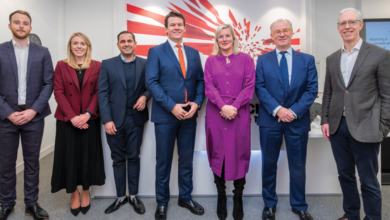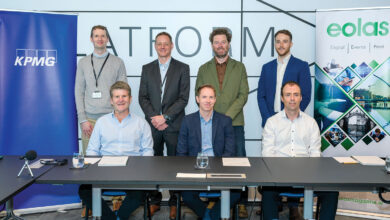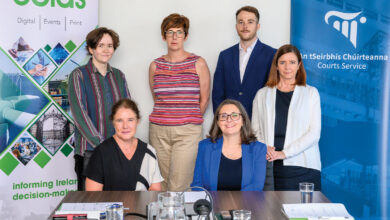
HP hosted a working lunch drawing together various stakeholders from the public sector looking at future digital transformation. The discussion ran the gamut from 5G to drones, through to 3D metal printing.

What are the current challenges around workplace transformation and employee engagement?
Seán Keevey
Digital transformation is not just about technology. It’s primarily about cultural change and this can be difficult to achieve. There can be a fear of digitisation, and we need to overcome any such fear through communicating what we are doing and why we are doing it. We need to bring people along on the [digitisation] journey. We particularly need to focus on the end user experience, how people want to interact with us and the benefits that can be realised. A lot comes down to business change and culture change. Technology is also important, particularly where legacy systems are involved and there is a need to get the infrastructure up to date.
Damian Griffin
The Defence Forces require secure yet frictionless delivery of IT services as an enabler to the mission. This consumption and ultimately the improvement of IT services in the office, through training and during tactical operations must be driven by user perception. Military management require user driven digital systems to enable the accurate delivery of information both up and down our chain of command. Our key to this workplace evolution is the assurance of security across any solution connecting our personnel through technology to enable processes of the organisation. Security is a great challenge for every solution but no longer a blocker.
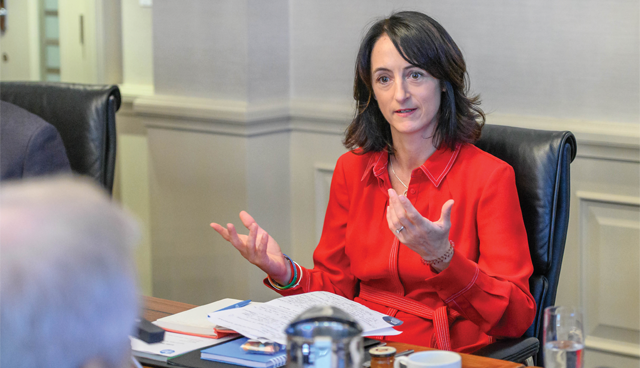
Using Geographic Information Systems has become the norm and the technology in that space is developing rapidly with huge value to offer any organisation or individuals dealing with spatial data.
Darach Green
People are the challenge, more so than technology. It’s building confidence in IT to deliver with people on the ground, our own staff and particularly providing services to judges, who are an independent entity separate from the Courts Service – it can be quite a challenging environment. We try to get a balance between what they think is possible and what is deliverable. Digital transformation has to be business-led. As regards legacy systems, again it’s a balance between keeping those legacy systems going and at the same time updating and modernising your operating platform. Other challenges are finding and retaining staff and security.
Neil Dover
Technology is redesigning the workplace, we are entering a new era of IT – one that fundamentally reimagines where we work, the way we work, and how we provide the tools for work. We are untethering from the desktop, both as a physical surface, and as a machine. HP Device as a Service (DaaS) offers a futureproof flexible solution to support workplace transformation and engagement – the solution combines hardware, analytics, endpoint security and device lifecycle service. The greatest barrier we see as an organisation is that over 72 per cent of employees say outdated technology harms productivity.
Loretta Lambkin
Capacity and capability of staff. Transformation projects need to be led and have full involvement of business users and resourcing must adapt to those needs. The planning sector is getting busier and, given pressures of workload, it’s often hard to release staff to get involved in projects. Capability is also a challenge as there are different skillsets required (project management, business analysis, software development and testing) in organisations to drive transformation projects. We need to recruit staff or procure services to provide these skills which requires investment to attract the right type of IT expertise. We also need to continue to build the capability of our own staff through learning and development opportunities and knowledge transfer from contracted experts.
Robust cyber security policy to protect data, documents and devices is critical to business success, what are the key security considerations in your digital transformation process?
Loretta Lambkin
Security considerations for paper and digital files are completely different and often complex. For example, the various stages of our case management processes have different access requirements which have to be carefully detailed, documented and deployed to ensure security of files. Also, in the future, when we’re relying on the digital file, systems will have to be built to deal with ransom-ware threats which a number of companies in the USA are currently dealing with. If that happens in a fully digital system, we need to have access to duplicate systems that can be ramped up straight away so that access to the full digital file continues to be available.
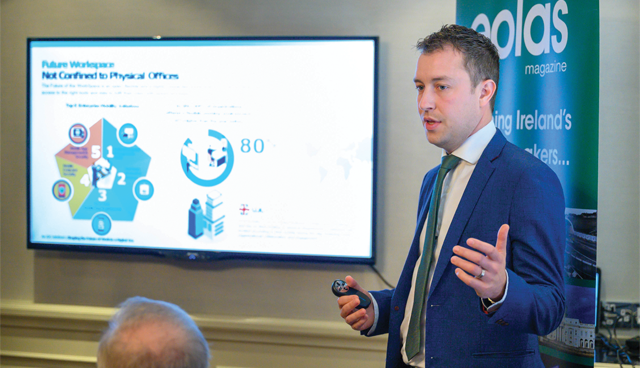
The greatest barrier we see as an organisation is that over 72 per cent of employees say outdated technology harms productivity.
Darach Green
We are very paper based as well. One of the issues is the legality of paper, which has been established for centuries, versus digital and the legal world has to embrace that; they recognise a signature on paper a lot quicker than they would the digital equivalent, which is something we need to change. Replacing paper with digital versions is going to be challenging; we have started on that road, but there’s a way to go. I think we all have nightmares about losing our main files and what happens, but we need to address it. We’re also addressing GDPR by putting in place all the standards and processes expected of us and we’re getting there, but then you always have to follow it up and continue building on it.
Damian Griffin
We are transitioning from paper to a digitally enabled organisation as we achieve our mission across land, sea, and air. Our challenge is to deliver the appropriate level of security to the end user at all times. Paper files provide the illusion of knowing where your data is, it’s in the file, in the cabinet, IT must deal in securing the reality. The Defence Forces has a security first culture which will now redefine and streamline trusted processes to deliver a new digital reality. To deliver on the security of data the Defence Forces team must ensure the end user has all the tools required to complete the task. Any organisation without this open mind set to deliver the correct workplace technologies will continue to suffer the increasing challenge from ‘Shadow IT’. Workplace technologies need to be secured through a mesh of data security and identity management to ensure the correct delivery of data in a frictionless manner.
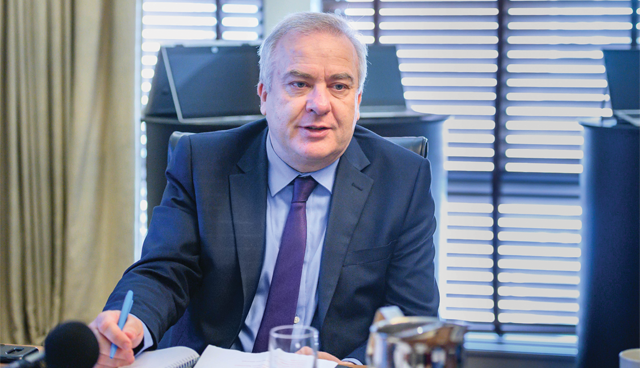
There’s a big push from the EU for the justice sector to start using AI. It’s nearly like a solution looking for a problem.
Seán Keevey
With digitalisation comes increased security risks in terms of data. In the context of data, documents and devices we have achieved ISO 27001 certification about three years ago and one of the areas we had to particularly concentrate on was changing people’s behaviours even in the elementary way of making sure staff wore their lanyards at all times and that they didn’t hold security doors open for other people. A lot of this security is about people’s behaviour, like stopping people from opening emails that they shouldn’t open. We have a cyber security team in place who do the monitoring and defence, but a significant part of their job is communicating with people. We all need to be aware that security risk is not just an IT risk, it’s an organisational one. It’s always important to have contingency plans in place for when something happens, because something is always going to happen.
Neil Dover
Businesses tend to think about cyber security as an operational problem, which is to be addressed by deploying and managing the right software and network tools. In fact, in today’s threat landscape, choosing a device is already a security decision, as hardware provides the foundations and low-level security that is increasingly critical to any operating system, software security solution, and robust recovery on and around endpoints. HP has been a leader in endpoint device security for over two decades, pioneering research, driving security standards with industry partners, and raising the bar of personal computer and print security, with many industry firsts. We are continually innovating to deliver the world’s most secure devices, along with the solutions and services to manage our customers’ risk. We recently announced our AI based malware detection tool Sure Sense to address the problem of Zero Day attacks.
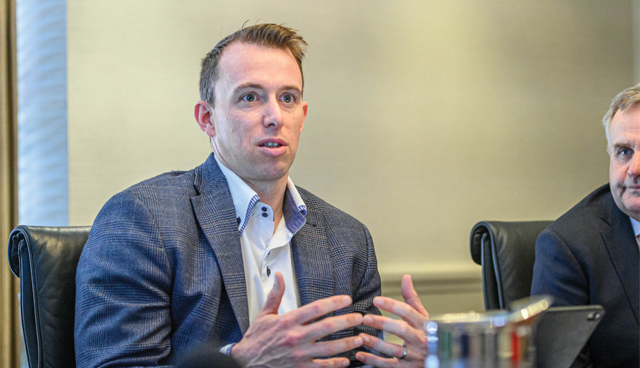
Paper files provide the illusion of knowing where your data is, it’s in the file, in the cabinet, IT must deal in securing the reality.
Damian Griffin
The challenge is to shift from the infrastructure mind set of managing things which has for generations delivered in a structured fashion. We must now set the rules and conditions around organisational data and manage it from the data centre be it public, private or hybrid to the end device user. Data security requires a level of automation and process to enable accurate delivery and retention.
How is your organisation taking advantage of new technologies such as the Internet of Things (IoT)? To what extent does IoT disrupt established relationships between businesses and customers?
Loretta Lambkin
An Bord Pleanála is still at an early stage in our digital transformation process but our future plans will take account of the potential that is there. As we commence work on our website and portal the design and development will be on the basis that our services can be accessed at any time and on many different types of devices. Our ICT Strategy also considers use of technology to support the work of planning inspectors, whether that’s using hand-held and other devices to capture data and information immediately on site or making hearings more accessible to the public. The opportunities are endless.
Seán Keevey
Currently the Department doesn’t have a direct role with IoT, but the agri-food industry is heavily into it; in areas such as milk production and animal welfare. Our job is to provide a space for it in terms of research and policy development etc, but also there’s a huge amount of data coming out of IoT that that could be used by the DAFM to help improve its support for the industry. For instance, if you have herds of cows and you can see the animals’ temperatures rising in a cluster; it could indicate a disease outbreak.
Damian Griffin
The Defence Forces has delivered IoT for decades. We’ve always deployed end user devices to enable a decision locally, 100 miles away or in another country. To affect continued success the Defence Forces will innovate, we need to try things out and make an improvement. Delivering focused proofs of concept allows interesting solutions to deliver change to the end user. It’s about empowering small teams with the expertise and authority to deliver the mission. Again, if we can set the conditions around data the use of devices can only enhance our organisation in support of the nation.
Darach Green
From the Courts Service’s point of view there’s probably a limited amount that can be done with IoT. What may come in is the use of devices for evidence display in the courtroom. Evidence may come in on any device involved in a crime. We haven’t got to that point yet but I can see a future where a drone has evidence on it and we have to figure out a way to get that evidence into the courtroom. It’s something that we’re thinking about at the moment and it’s where the challenges will arise for us from IoT. Otherwise, it’s the more straightforward challenge of newer, younger judges coming in and looking for digital casefiles across devices.
Neil Dover
3D printing is huge for us. Manufacturing is a $50 billion industry and 3D printing is really disrupting that. There are so many scenarios for it, whether it’s ad hoc printing for parts rather than storing them or something else, and it means your turnaround time is lessened. As well as that we can start designing sensors into things and with wear and tear on the device, the sensor could tell you when it needs to be replaced. In an area like the health service, you can now print a hip specific to an individual. You can build a sensor into that hip to tell you where the wear is happening. We’re seeing massive traction with the capabilities of 3D printing. It’s going to completely change the cost of manufacturing and the way we design for manufacturing. It’s interesting to print something like a Rubik’s cube as a good example of a three-dimensional object that is moving and working immediately out of the box. HP has announced recently that we’re now printing in metal, which again is transforming how we think about design.
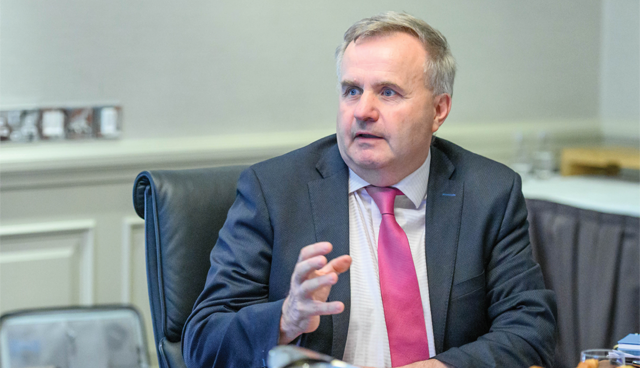
We need to bring people along on the [digitisation] journey. We particularly need to focus on the end user experience, how people want to interact with us and the benefits that can be realised.
Seán Keevey
Another area for us is AI, which has promised a lot and will probably deliver big in a few years, but for now we’re taking an incremental approach to its use. One interesting area that we are presently focusing on is data protection and GDPR and using AI to help predict online activity by people that could lead to accidental data breaches. We’re also looking at bots for our call centre in order to automate answers to questions people might have. We are piloting a ‘bot’ internally at the moment and should it prove successful we will make it available to our online customers.
What are your predictions for digital disruption in the months and years ahead?
Neil Dover
By 2025, 75 per cent of the workforce will be composed of millennials for whom technology is not merely a utility, but a way of life. Competitive advantage in both output and recruitment will partially rest on availability and access to the latest technology, always. Flexible and remote working will be assumed, rather than fought for and working away from the office will open new possibilities in who works with whom; breaking down hierarchies and silos as the best people for the job are linked by a Drive space, rather than physical proximity. Back office functions we predict will be largely automated, transforming businesses into networks of professionals more than structured organisations with teams of support staff to maintain infrastructure – HP predict this function be overseen by dedicated third parties, paid on a subscription basis.
Darach Green
There’s a big push from the EU for the justice sector to start using AI. It’s nearly like a solution looking for a problem. It won’t be replacing judges in the future, which is possible in theory, but in practice unlikely.
Seán Keevey
I think 5G is going to have a huge impact over the next few years. In the agri-food industry I expect that it will support a significant increase in the use of remote devices and sensors as well as provide near real-time communications for autonomous vehicles. Getting 5G up and running and in use is probably going to take a number of years.
Damian Griffin
Organisations must evolve securely and deliver on a digital strategy. Technology will not only disrupt but should be a tool to enable your organisation to move at an increasing digital pace. Disruption will deliver an opportunity for those who are prepared and open to change.
Seán Keevey
On digital, I think there’s a fatigue and fear factor setting in together with an element of distrust from citizens because of issues like recent the Facebook / Data Analytica controversies. We need to be sure that citizens can trust that we treat their data in a safe way and that it is safe for them to use digital technologies.
Loretta Lambkin
Across the planning sector, using Geographic Information Systems has become the norm and the technology in that space is developing rapidly with huge value to offer any organisation or individuals dealing with spatial data. Similarly, Building Information Modelling and other tools which enable digitisation of development are expected to result in benefits and changes to Ireland’s future planning and building control processes.
Participants
Neil Dover
Having been with HP for over 10 years, Neil Dover has served as the company’s Public Sector Manager, Personal Systems since November 2013. His duties include building strong professional relationships with Government and end user customers, as well as integrated planning and execution to ensure customer expectations on solutions. He holds a BSc in Computer Applications from Dublin City University.
Damian Griffin
Damian Griffin has almost 25 years of experience working in the security-first environment of the Defence Forces, where he has attained the rank of Commandant. He has continually delivered secure and innovative IT solutions for Defence Forces personnel in Ireland and deployed to overseas missions across land, sea and air. He holds an MSc from the University of York and is a graduate of NUIG and The Military College.
Seán Keevey
Seán Keevey is Chief Information Officer in the Department of Agriculture, Food and the Marine. Seán has over 30 years of experience in ICT – across a number of Departments and organisations. His main areas of concern are the on-going digitisation of services in the Department and the greater use of data through reporting and data analytics and the development of ICT as a profession. Seán is a member of the Government wide ICT Advisory Board and is also a Fellow of the Irish Computer Society.
Loretta Lambkin
Loretta Lambkin has been the Chief Officer of An Bord Pleanála since 2013. She was previously acting Chief Executive and Director of Marketing for the Dublin Docklands Development Authority. She is currently overseeing the deployment of a new case management system, website and portal to enable a fully digital service for the submission of planning appeals and applications. Loretta holds an MBA from the University of Maryland and is a graduate of Trinity College Dublin and UCD.
Darach Green
Darach Green is ICT Manager in the Courts Service. He is responsible for making a major contribution to the strategic vision and change within the organisation, as well as creating and overseeing the ICT strategy and its execution. He manages and allocates the multi-million-euro ICT budget.


